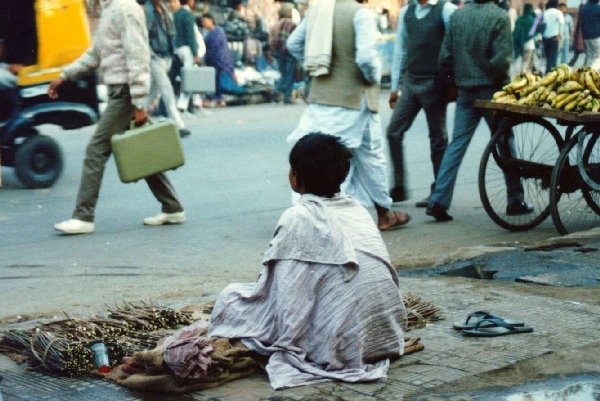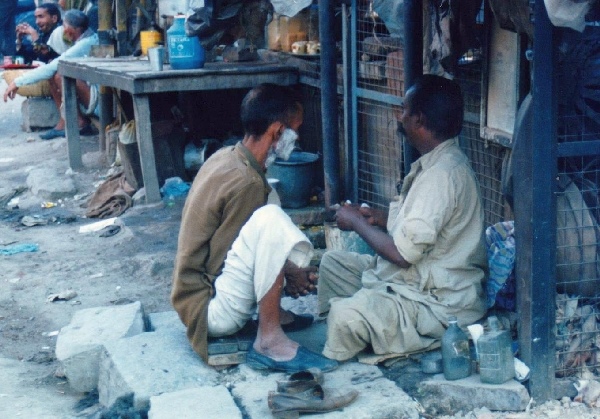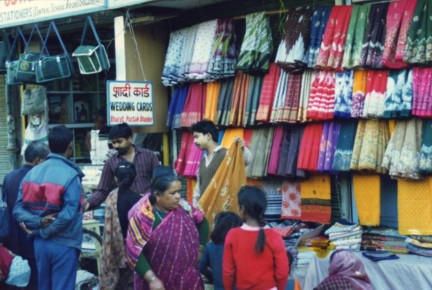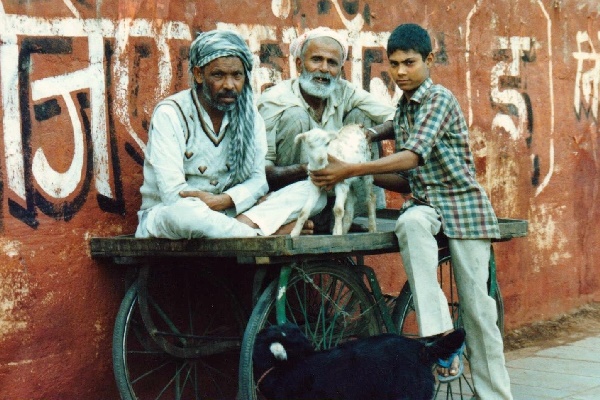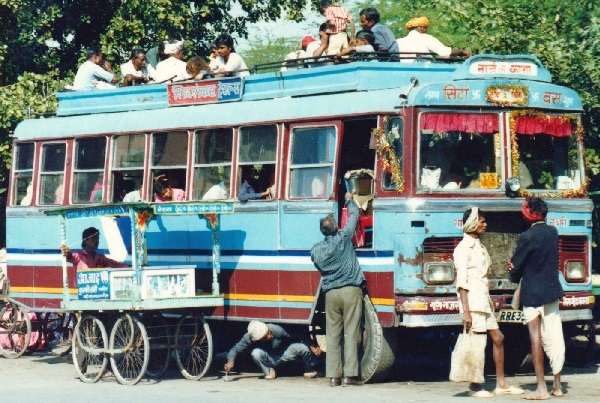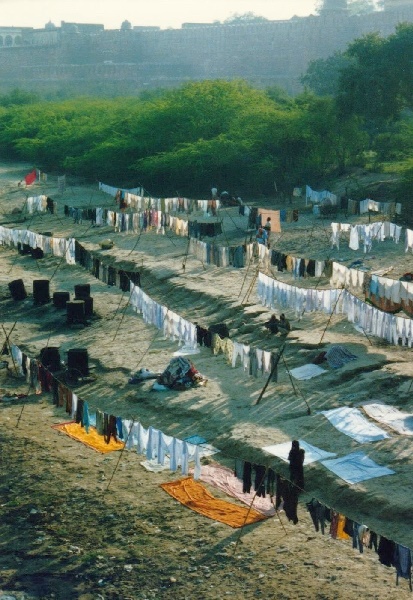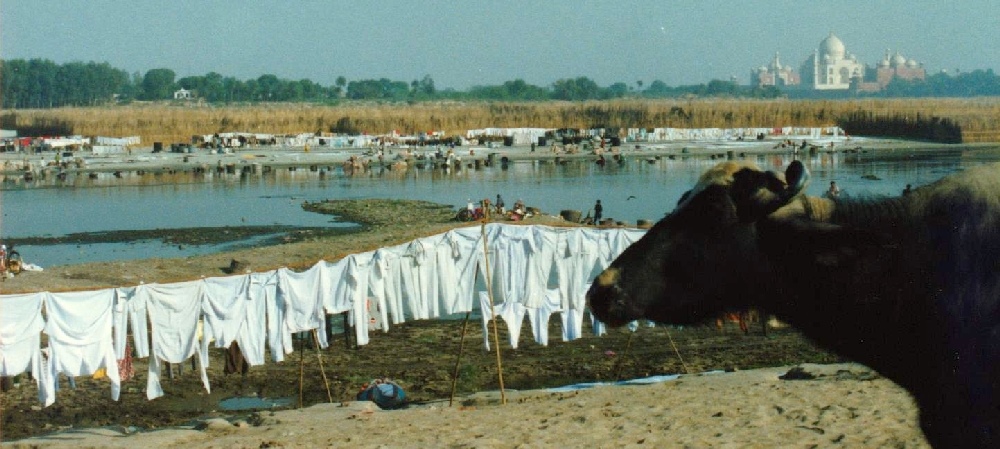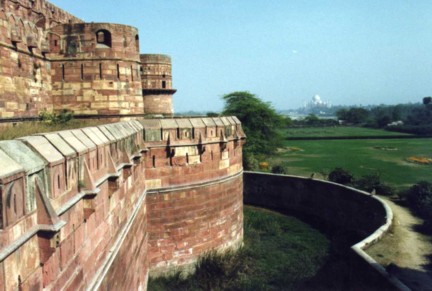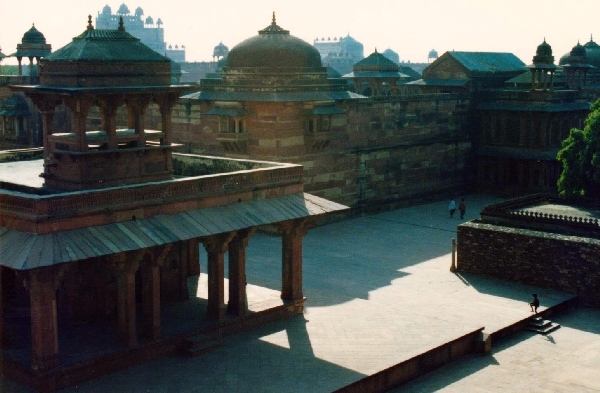World traveler Clown Tom Bolton
Adventure stories & photos

Tom’s travel to Northern India
Capital city of Delhi
I arrived in Delhi in Northern India early 1990 on my first trip. My adventures there and in Agra are presented here and the continuation of this trip to Varanasi and Rajasthan on the page – Northern India 2.
New Delhi, main train station
I had first gone to the central area around Connought Place, which has many hotels oriented towards westerners but I found it rather pricey for my budget. I had been spoiled the previous years by trips to Thailand and Nepal where one could still get a good place for about 2 dollars. I ended up at one of the better dives across from the New Delhi train station but wouldn’t recommend the area except for hardcore backpackers on a shoestring budget.
Were also lots of cheap restaurants there although most seemed to wash the dishes outside in buckets of filthy water, which I would not be surprised if it came out of the river. There is a huge slum along the train tracks nearby. In 1990 there were estimated to be 300,000 people living in these huts made of scrape. Sad but then at least an equal number of people were living directly on the streets of Delhi, whole families, destitute with no roof over their head – so that one often had to walk in the streets at night since the sidewalks were full with sleeping bodies.
Performing in the slums
I made some shows right in the middle of this slum located along the train tracks. Like all over India, I felt basically safe but the people got so excited that performing nearly lead to riots. There were always new people arriving who insisted that I do another show so that it was difficult to leave. This gave me an idea that I have never gotten to realize of renting an elephant. One could ride into any town or village, make a show, end it on top of the elephant and stroll away again without interference.
Anyway, the poverty overwhelms many visitors to India. My feeling is that even though I occasionally bought someone a meal, they would be hungry again the next day. But the memory of seeing a crazy foreigner show up in their neighborhood to make a free show might stay with people a lifetime.
Delhi cows in the street
The proverbial holy cows. They often had free run in many cities including Delhi back then. In Varanasi they were often aggressive. It seemed that they somehow knew that nobody would retaliate against them. I’ve heard that they are being relocated out of the biggest cities for their own protection and to stop animal related traffic jams.
And what does a cow in Delhi eat where there is little or no grass or plants available? The answer is garbage and paper! I would eat a banana and having no place to deposit the peel anyway, I would simply look for the next cow to give it to. Food sold from food stalls or items bought in a shop were usually wrapped in newspaper, which would get thrown in the street and eaten by the cows. From what I understood, nobody could actually own a cow but often one was dressed up in ceremonial garb and used by “holy” men for religious rituals.
Cow dung business
Cow dung is also a valuable commodity; collected, dried and burned. I always wondered if the dung vendors got a premium price for some good “Delhi brown” since it must tend to have a high paper content. Here was a Delhi dung merchant doing the biz of drying and sorting – never thought to ask what such a person’s caste is since such a dirty job would normally be quite low but it is a useful enterprise and cows are holy. And the fact was, just walking around Delhi was a dirty job. By the end of the day, my cloths and body would be filthy no matter how hard I tried to stay clean.
Indian movie industry
The Indians are crazy about movies and have a bigger film industry than Hollywood. They generally stick to strict moral guidelines with lots of people dancing and singing at the drop of a hat. Western women are generally depicted as having loose morals and western men as being money crazed capitalist pigs. Since not everyone in India has a TV with satellite or cable reception nor DVD and video players, cinema has retained a bigger role as mass entertainment.
Amusement parks entertainment
Occasionally one would spot a Ferris wheel or even a small park with additional rides for kids. Such things must be a welcome relief especially for the poor. Not that they have a lot of money for entertainment but especially in a city the size of Delhi, going to a movie, having a ride or just eating an ice cream is a cheap diversion from a hard life. Near such places I would see a group of kids and of course do some juggling if I had any props with me. Otherwise, just doing some simple magic tricks and nonsense often got a positive response.
Beggars and annoying sellers
When I did get someone annoyingly trying to beg or sell me something I found it most effective to just ignore him or her. Sounds simple but you have to do it right. If you allow communication even by saying “no” or “go away” you will never get rid of them. You have to pretend that they are not there. The more they try, the more you just look through them. I found this to be 95 % effective in totally confusing such people that they gave up which was even entertaining at times. For the other 5% that persist, one must eventually tell them to get lost in a loud and aggravated voice.
Indians are very emotional and they don’t understand the attitude of “keeping cool”. If you tell someone to go away but don’t show annoyance in your voice and body language then they won’t take it serious. Let it be known that you want to be left alone but without being too disrespectful that it escalates into a brawl. Some people are very shady characters but others are simply poor and desperate and one can’t blame them from trying to earn something.
Most beggars are handicapped
Occasionally, a normal person would approach a westerner just to see if he could get something. Otherwise, since there is so much poverty, the rest of the society just doesn’t accept people simply begging unless they have a serious handicap like this woman camped out front of a Hindu temple.
Beggar in Mosque
This is a view of the inner sanctuary of a mosque in Delhi. There were often handicapped people begging outside of mosques especially after Friday prayers. I think due to the Muslim teachings of the importance of charity, it makes it a profitable situation. The beggar squatting in this picture was counting his takings, which seemed a bit sacrilegious there.
Delhi red fort/mosque
These images show the exterior and outer walls of the main tourist attraction in Delhi, the red fort, a massive fortress and mosque complex. There is an older citadel farther south also near the river but I had decided at the time to stick to the main attractions mostly within walking distance or easy rickshaw taxi ride. With hindsight I realize that there were a lot of really worthwhile places I missed but everything was so dirty and hectic that I didn’t stick around Delhi long.
Remove shoes at Mosque entrance
Like in most Indian mosques, non-Muslims can visit in the red fort. One still needs to follow the customs of taking off the shoes at the entrance. In this photo an old woman stayed behind to watch the family’s shoes and watch the baby who had a fun time trying the shoes on.
Mosque interior
Like in most mosques, there was a pool where believers were supposed to wash before going into the buildings. The architecture here was massive and impressive with typical Islamic usage of multiple archways. Interesting was that some seemed to pray in the courtyard without even going into the Mosque interior.
Delhi Hindu Temple
Various Muslim rulers held sway over Delhi and left a strong architectural influence. After partition with Pakistan much of the Muslim population left Delhi and Hindus and Jains from Pakistan ended up here. With over 80% of the population being Hindu there is of course a multitude of Hindu temples including the biggest in the world, the Akshardam complex that I somehow missed! I did get to the Laxminarayan temple, which was full of colorful deities. One also had to leave the shoes outside but they had a place to check them at which was a madhouse.
Snake charmers
Yeah, there really are snake charmers to be seen on the streets of Asia not just in India. These boys had a good spot just in front of the temple. This is often a career passed down from father to son. Unfortunately, any such street performances in India don’t bring much money nor are they seen in a good light, which is especially hard in a society, still regulated by caste.
Working in Delhi, boy selling sticks, no childcare
It was fascinating for me to observe what people did to survive in this mega city. One hears that Calcutta is even worse but the filth and poverty was an eye opening experience. That many children had to work to keep the family fed was painfully evident. This boy sold small bundles of sticks, which people in homes or on the street would burn to heat their food or tea and get a little warmth. Other kids might not be actually working yet but with no daycare get dragged along to their parents’ work.
Commodity sellers
Of course there were also the big wholesalers of wood, coal or building materials like sand and gravel. Usually there were multiple places clustered together so one would have a whole block or more of similar places.
Garbage removal
The garbage men didn’t have nice plastic garbage cans to empty into compacting trucks. Waste was swept, shoveled and handled by hand
Rag pickers
I didn’t visit an India dump but of course many people live as trash pickers sorting out the refuse. Every bit of metal, glass or wood will be scavenged. Here was a rag merchant where the old textiles would land.
Street barbers
Street corner barbers were also plentiful. Not sure that a haircut would be such a big deal but having a shave with a razor that had drawn blood from who know who looked rather unsanitary.
Souvenir street
There was a whole street I found where such souvenirs were sold to the tourists. Seems this was a pretty good business even if they managed it without high overhead. Most of what was sold in this section was textiles.
Sari shops
This shop was selling the mainstay of Indian women’s fashion: saris. I hear that even the most modern upper class women who mostly wear western clothing on a daily basis will have a collection of fine saris for formal occasion. Seems nice that they haven’t lost the appreciation of these often-beautiful garments.
Small food shops
In the old city I mostly saw small food shops like this although I can imagine that big supermarkets must exist now in the upscale neighborhoods. I bought some oranges in one such local bazaar and tried one of my first Indian street shows. Within minutes the police shut me down. Not that they really had anything against me but the people got so excited that it was turning into an unruly mob and they didn’t want things to get out of hand.
Outdoor markets, food carts
Besides shops there were many outdoor markets.And many businesses were run out of a cart, which with a sheet of plastic would often double as a shelter for the night for a family.
Cart and goats
Saw these characters with a cart and a couple of goats but don’t know if the goats were supposed to be for sale or what?
Street photographers
The photographers “get your picture taken against a backdrop” set up seems to be pretty universal in third world countries near any popular tourist attraction.
Trains station porters
There were many porters or “coolies” at the New Delhi train station who would get hired out to load and unload goods. Seems they had an organized system as the official ones all had red jackets.
Navy recruitment
Like in America, India has volunteer military services. One has to have some physical fitness and probably read and write, which eliminates some of the most desperate. But otherwise, it would seem as an escape for the under privileged.
Transportation, rickshaws and carts
Of course workers and their goods need to be transported. While there are car and motorized richshaw-taxis, there are plenty of bicycle taxis. And many goods are still moved by carts pulled by horses or mules. Many such beasts of burden seemed to be in poor shape but the stress for human rickshaw drivers is nothing to scoff at.
Eve teasing
What the heck is that about was my first thought upon seeing such a sign? With western woman the Indians are notorious grabbers but they can’t get away with that with local women. At least in theory. But some try to chat them up anyway and this is known as “Eve teasing” which is officially illegal. I think it is correct to make men think about if their behavior is appropriate. But even in doing this they seem to white-wash the reality of outright harassment, groping and rape. But I guess public service announcements wouldn’t go over well if they said; men stop being assholes.
Rickety long distance buses
One of my first views of a typical long distance non-express bus. Spending a little bit more for a 1st class train or express bus, if one could get a reservation, was always a wise investment.
Christian cemetery price list
I came across a Christian cemetery in Delhi. The percentage of Christians is low but one still has to bury them somewhere. Not sure how the prices compare to cremation but then there is the upkeep of the graves. And with such a large population, one has to wonder where all of the graves would go if everyone got buried there. Probably they would have to do like in Germany and reuse graves after a few decades.
Leaving Delhi
I had run around Delhi looking for a bank that would rent me a safe deposit box to store my flight tickets and some of my travelers’ checks for my onward trip to the Philippines but had no luck. The few banks that had such a service said that they were all rented out to long term customers.
I took a train to Agra, reservations having to be made in advance. I first went to the upstairs office for foreign tourists. It was well outfitted with air-conditioning and computers but tickets there had to be paid for in dollars or pounds, cash only but I only had rupees and travelers checks with me. The normal office might have sufficed but they wouldn’t let me in with a camera and I ended up having to go to a bank and by then the office was closed and I had to return the next day.
Agra
Taj Mahal
Upon arrival in Agra, touts surrounded me. I tried to take a bicycle rickshaw to the Taj Mahal just to get away from the scene but the motorcycle rickshaw drivers made a big argument about it. I just started walking with my backpack and after about 20 meters dove into the bicycle rickshaw and off we went with plenty of shouts hurled our way.
My driver turned out to be cool. Upon arrival at the Taj, I mentioned that I really wanted to go to a hotel first and he took me the rest of the way to a nearby place mentioned in my guidebook for no extra charge. The Taj is deservingly one of the man-made wonders of the world. The famous white marble domed building that everyone recognizes is actually a mausoleum made for a wife of Mughal Emperor Shah Jahan and is just part of a large complex with various beautiful buildings and extensive gardens.
First I had to have someone take a shot of me posing in front of the Taj like hundreds of millions of tourists before me. A view from an angle shows one of the two large buildings that flank both sides of the main one.
Intricate detail work
It’s not just majestic from a distance but intricately inlayed with precious stones and fine details, which distinguishes it from the many fort/temple/mosque complexes throughout India.
Taj complex is multiple buildings
Here are a couple of views of the side section to the Taj Mahal complex. The white building is the cliché’ but the brown building and surrounding sections are even bigger and also beautiful. The side buildings are nearly identical but the western one was used as a mosque, thus the pool for washing in front of it.
Most tourists were Indians
Here are views from the main building back towards the gateway entrance. What surprised me at the Taj was how few of the masses of tourists were foreigners there in 1990. I know that the occasional bus full would visit but I think I only saw about 10 westerners inside – out of thousands. Interesting was the gardener cutting the grass. Rather than a gasoline or even electric lawn mower, it was mechanical pulled by oxen. One needs to remove and check their shoes before entering the area around the main building.
Around the Taj
Garbage dump and toilet
Yet the banks of the river behind the Taj are used as a garbage dump and communal toilet. But then everywhere in India is used as a toilet since there are so many people and a lack of public facilities. And in India, like many developing countries, toilet paper is not commonly used. One cleans their behind with water taken with their left hand. Coincidentally, in many such countries, food is often eaten with only the hands. Logically, touching food with the left hand is a strict taboo!
Laundry by river behind Taj
Here a couple of shots of the Taj from behind, across the river. This is how laundry is done throughout India. You give your cloths in at your hotel and they send it off to such a service where it is washed and dried at the local river. Somehow mountains of cloths are cleaned on a daily basis and it is claimed that all your things come back without mix-ups. But the mystery that impressed me more was how they get things so clean despite the questionable water quality.
Fake Taj Mahal
Surprise, this isn’t the Taj! This Agra building, the Itmad-Ud-Daulah’s Tomb is known as the “baby” Taj Mahal. It’s impressive in its own right but lacks the delicate inlay work and setting of the original.
Agra Red Fort
The other jewel in the crown of architectural wonders of Agra is Lal Qila better known as the Red Fort, located along the river some kilometers away from the Taj. Not to be confused with the smaller Red Fort in Delhi, this huge complex can actually be considered a walled city. It was founded around the 11 century and became one of India’s most important and contested places. It seems that most of the rulers of northern India based themselves here at some time. Originally built of bricks and damaged numerous times, its present construction out of sandstone blocks was refined by Shah Jahan, who is attributed with the construction of the Taj Mahal, which is easily viewable from the fort.
Red Fort advertisements
I think this is the outer wall towards the river. So many places have been so nicely preserved in India and then suddenly you see these advertisements. I didn’t know if I should be disturbed by it or just happy that it isn’t more common. On the opposite side of the fort is one more huge, spectacular mosque called Jama Masjid, which should be visited in connection with a day at the fort. I suspect many tours rush through Agra and miss seeing it by trying to visit both the Taj and the Red Fort in a day, which is like trying to appreciate all 100 flavors of ice cream at a great gelataria.
Northern India continues next page
I also made a day trip to the town of Fetehpur Sikri. The great Mughal emperor Akbar had ruled from nearby Agra Fort and built a complex including a palace and mosque here. It’s claimed that it took 15 years to build and was abandoned after only 14 years because of water shortages. It is still not inhabited and thus well preserved. I don’t have any photos because I had problems with my camera. It was jamming and I changed the batteries a couple of times but I also lost a whole roll of film that somehow didn’t advance. From Agra I got a train to Varanasi but the story continues on the page Northern India 2.
So, those were just a few tales from my many travels over the last thirty and something years. I hope you've enjoyed another side of a traveling clown! If you want, write me an email or better yet, book my show or set a link to this website or just state me as the beneficiary of your will!
To book or see more information about Tom's clown show and entertainment, visit one or both of his clown websites:
Clown Stuttgart www.clowntombolton.com
Clown juggler Stuttgart, Gremany www.clown-event.de



































